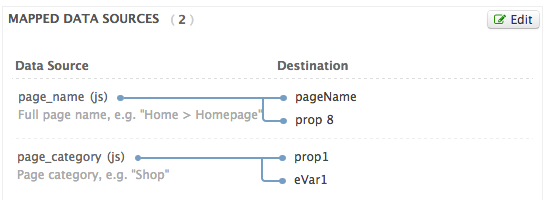Tealium Import Data Layer extension 
This Tealium extension captures data from existing JavaScript objects in the page.
You may find this useful if you are deploying Tealium (or other data solutions) on pages that already have a data object in place, particularly from existing SiteCatalyst implementations or from W3C data objects.
Usage
You will need two parts: the code library, and a configuration block.
Step 1: Create configuration
Create a JavaScript Code extension in your Tealium profile to hold the configuration.
The basic configuration is in the utag_extn.import_datalayer namespace and looks like this:
utag_extn.import_datalayer.config = {
data_layer_name : ["s.variableName"],
// .. more fields ..
};There is more information about the configuration required below.
Step 2: Install code library
Copy the source code for the extension, which is in import-datalayer-extension.js and add it to your Tealium profile as JavaScript Code extension. This must go after the configuration: remember you can drag-and-drop to reorder extensions.
Capturing (legacy) SiteCatalyst data
If you want to build a UDO in Tealium from existing 's' object data in the page, you need to build effectively the reverse of the mapping table. For example, you might have this data in the page:
<script type="text/javascript"><!--
/* You may give each page an identifying name, server, and channel on
the next lines. */
s.pageName = "Home";
s.prop1 = "personal";
/************* DO NOT ALTER ANYTHING BELOW THIS LINE ! **************/
var s_code = s.t();
if (s_code)document.write(s_code);
if (navigator.appVersion.indexOf('MSIE') >= 0) document.write(unescape('%3C') + '\!-' + '-');
//-->
</script>You would need to have this in the mapping table:
Then the configuration will look like this:
utag_extn.import_datalayer.config = {
page_name : ["s.pageName"],
page_category : ["s.prop1"]
};This will capture data into the correct UDO variables.
Fall-back data sources
You can specify multiple sources for the data. The rule is that the data will be captured from the first variable in the list that is matched. For example, if the SiteCat pageName variable is not set on some pages, you might want to capture the document title instead. In this case, the configuration would look like this:
utag_extn.import_datalayer.config = {
page_name : ["s.pageName", "document.title"],
page_category : ["s.prop1"]
};If s.pageName is present on the page, then it will be passed in to utag_data.page_name.
If it is not present, then utag_data.page_name will have the value of the document title.
If the title is not present (or it's empty) then the variable will not be set at all in the
data layer.
W3C data sources
The data sources are defined in the W3 Customer Experience Digital Data Layer 1.0 spec. You can capture these variables using the same configuration syntax as above:
The data in first example would look like this in W3C format:
<script type="text/javascript">
window.digitalData = {
pageInstanceID: "Home-Production",
page: {
pageInfo: {
pageID: "Homepage",
destinationURL: "http://www.customer.com/home"
},
category: {
primaryCategory: "personal",
pageType: "content"
}
}
};
</script>And you could collect it like this:
utag_extn.import_datalayer.config = {
page_name : ["digitalData.page.pageInfo.pageID"],
page_category : ["digitalData.page.category.primaryCategory"]
};The output mappings would be exactly same on the SiteCat tag.
Data layer migrations: SiteCatalyst native to W3C
You can also combine multiple data sources in the list, so that you can have a phased roll out. For example, you may be migrating from an existing SiteCatalyst native data object to a W3C format data layer, This configuration captures the W3 format data if it is present in the page. If not, the variable will be populated from SiteCat.
utag_extn.import_datalayer.config = {
page_name : ["digitalData.page.pageInfo.pageID", "s.pageName"],
page_category : ["digitalData.page.category.primaryCategory", "s.prop1"]
};Data layer migrations: SiteCatalyst native to Tealium native
If you are migrating from a SiteCatalyst data object to a native Tealium UDO (data object) in the page, then you don't need to specify the Tealium fields in the configuration. The code will not overwrite existing values in the UDO if they are already set.
<script type="text/javascript">
window.utag_data = {
page_name : "Homepage",
page_category : "personal"
};
</script>If you have this configuration to capture your SiteCatalyst data:
utag_extn.import_datalayer.config = {
page_name : ["s.pageName", "document.title"],
page_category : ["s.prop1"]
};Then the UDO will still be populated with the values from the page, because they will take priority over the SiteCatalyst data.
Running the tests
You can run the tests from the command line using Mocha-PhantomJS
npm install
npm test
Alternatively, if you want to run the tests or contribute to the extension code, there is a simple web server in Node.js:
npm install
npm start
This gives you LiveReload functionality so the test page will reload by magic whenever save the files.

